Waveform Complexity and Positioning Analysis of Acoustic Emission Events during the Compression Failure Process of a Rock Burst Prone Sample
Abstract
:1. Introduction
2. Methods
3. Results and Discussion
4. Conclusions
Author Contributions
Funding
Data Availability Statement
Conflicts of Interest
References
- Leake, M.R.; Conrad, W.J.; Westman, E.C.; Ghaychi Afrouz, S.; Molka, R.J. Microseismic monitoring and analysis of induced seismicity source mechanisms in a retreating room and pillar coal mine in the Eastern United States. Undergr. Space 2017, 2, 115–124. [Google Scholar] [CrossRef]
- Mark, C. Coal bursts that occur during development: A rock mechanics enigma. Int. J. Min. Sci. Technol. 2018, 28, 35–42. [Google Scholar] [CrossRef]
- Guo, W.-Y.; Zhao, T.-B.; Tan, Y.-L.; Yu, F.-H.; Hu, S.-C.; Yang, F.-Q. Progressive mitigation method of rock bursts under complicated geological conditions. Int. J. Rock Mech. Min. Sci. 2017, 96, 11–22. [Google Scholar] [CrossRef]
- Małkowski, P.; Juszyński, D. Roof fall hazard assessment with the use of artificial neural network. Int. J. Rock Mech. Min. Sci. 2021, 143, 104701. [Google Scholar] [CrossRef]
- Fulawka, K.; Stolecki, L.; Szumny, M.; Pytel, W.; Jaskiewicz-Proc, I.; Jakic, M.; Noeger, M.; Hartlieb, P. Roof Fall Hazard Monitoring and Evaluation-State-of-the-Art Review. Energies 2022, 15, 8312. [Google Scholar] [CrossRef]
- Wu, D.; Gao, Y.; Chen, X.; Wang, Y. Effects of Soil Strength Nonlinearity on Slip Surfaces of Homogeneous Slopes. Int. J. Geomech. 2021, 21, 06020035. [Google Scholar] [CrossRef]
- Zhang, J.; Huang, H.W. Risk assessment of slope failure considering multiple slip surfaces. Comput. Geotech. 2016, 74, 188–195. [Google Scholar] [CrossRef]
- Kovachev, S.A.; Ganzha, O.Y. Structure of the Earth’s Crust of the Persian Gulf According to Deep Seismic Sounding Results. Oceanology 2023, 63, 719–732. [Google Scholar] [CrossRef]
- Kovachev, S.A.; Krylov, A.A. Results of Seismological Monitoring in the Baltic Sea and Western Part of the Kaliningrad Oblast Using Bottom Seismographs. Izv.-Phys. Solid Earth 2023, 59, 190–208. [Google Scholar] [CrossRef]
- Kovachev, S.A.; Krylov, A.A. Microseismicity in the Persian Gulf and in the Zagros Mountain Massif according to OBS Observations. J. Volcanol. Seismol. 2023, 17, 474–490. [Google Scholar] [CrossRef]
- Krylov, A.A.; Novikov, M.A.; Kovachev, S.A.; Roginskiy, K.A.; Ilinsky, D.A.; Ganzha, O.Y.; Ivanov, V.N.; Timashkevich, G.K.; Samylina, O.S.; Lobkovsky, L.I.; et al. Features of Seismological Observations in the Arctic Seas. J. Mar. Sci. Eng. 2023, 11, 2221. [Google Scholar] [CrossRef]
- Feng, J.; Wang, E.; Ding, H.; Huang, Q.; Chen, X. Deterministic seismic hazard assessment of coal fractures in underground coal mine: A case study. Soil Dyn. Earthq. Eng. 2020, 129, 105921. [Google Scholar] [CrossRef]
- Zhang, W.L.; Ma, N.J.; Ma, J.; Li, C.; Ren, J.J. Mechanism of Rock Burst Revealed by Numerical Simulation and Energy Calculation. Shock. Vib. 2020, 2020, 15. [Google Scholar] [CrossRef]
- Aker, E.; Kühn, D.; Vavryčuk, V.; Soldal, M.; Oye, V. Experimental investigation of acoustic emissions and their moment tensors in rock during failure. Int. J. Rock Mech. Min. Sci. 2014, 70, 286–295. [Google Scholar] [CrossRef]
- Zhang, W.; Li, C.; Jin, J.; Qu, X.; Fan, S.; Xin, C. A new monitoring-while-drilling method of large diameter drilling in underground coal mine and their application. Measurement 2021, 173, 108840. [Google Scholar] [CrossRef]
- Zhang, W.; Huo, T.; Li, C.; Wang, C.; Qu, X.; Xin, C.; Berardengo, M. Characteristics of Valuable Microseismic Events in Heading Face of an Underground Coal Mine Using Microseismic System. Shock. Vib. 2021, 2021, 6683238. [Google Scholar] [CrossRef]
- Shang, X.Y.; Wang, Y.; Miao, R.X. Acoustic emission source location from P-wave arrival time corrected data and virtual field optimization method. Mech. Syst. Signal Process. 2022, 163, 108129. [Google Scholar] [CrossRef]
- Li, S.-c.; Cheng, S.; Li, L.-p.; Shi, S.-s.; Zhang, M.-g. Identification and Location Method of Microseismic Event Based on Improved STA/LTA Algorithm and Four-Cell-Square-Array in Plane Algorithm. Int. J. Geomech. 2019, 19, 04019067. [Google Scholar] [CrossRef]
- Pomponi, E.; Vinogradov, A.; Danyuk, A. Wavelet based approach to signal activity detection and phase picking: Application to acoustic emission. Signal Process. 2015, 115, 110–119. [Google Scholar] [CrossRef]
- Krylov, A.; Lobkovsky, L.I.; Ivashchenko, A.I. Automated detection of microearthquakes in continuous noisy records produced by local ocean bottom seismographs or coastal networks. Russ. J. Earth Sci. 2019, 19, ES2001. [Google Scholar] [CrossRef]
- Zhu, M.; Cheng, J.; Zhang, Z. Quality control of microseismic P-phase arrival picks in coal mine based on machine learning. Comput. Geosci. 2021, 156, 104862. [Google Scholar] [CrossRef]
- Ma, H.; Wang, T.; Li, Y.; Meng, Y. A Time Picking Method for Microseismic Data Based on LLE and Improved PSO Clustering Algorithm. IEEE Geosci. Remote Sens. Lett. 2018, 15, 1677–1681. [Google Scholar] [CrossRef]
- Meng, Y.; Li, Y.; Zhang, C.; Zhao, H. A Time Picking Method Based on Spectral Multimanifold Clustering in Microseismic Data. IEEE Geosci. Remote Sens. Lett. 2017, 14, 1273–1277. [Google Scholar] [CrossRef]
- Kim, D.; Byun, J.; Lee, M.; Choi, J.; Kim, M. Fast first arrival picking algorithm for noisy microseismic data. Explor. Geophys. 2017, 48, 131–136. [Google Scholar] [CrossRef]
- Liu, N.; Chen, J.; Wu, H.; Li, F.; Gao, J. Microseismic First-Arrival Picking Using Fine-Tuning Feature Pyramid Networks. IEEE Geosci. Remote Sens. Lett. 2022, 19, 7505105. [Google Scholar] [CrossRef]
- Guo, C.; Zhu, T.; Gao, Y.; Sun, J. AEnet: Automatic Picking of P-Wave First Arrivals Using Deep Learning. IEEE Trans. Geosci. Remote Sens. 2021, 59, 5293–5303. [Google Scholar] [CrossRef]
- Wang, J.; Xiao, Z.; Liu, C. PickNet code: Deep learning for picking seismic arrival times. J. Geophys. Res. Solid Earth 2019, 124, 6612–6624. [Google Scholar] [CrossRef]
- Diehl, T.; Deichmann, N.; Kissling, E.; Husen, S. Automatic S-Wave Picker for Local Earthquake Tomography. Bull. Seismol. Soc. Am. 2009, 99, 1906–1920. [Google Scholar] [CrossRef]
- Kim, G.; Seo, M.K.; Choi, N.; Baek, K.S.; Kim, K.B. Application of KLM Model for an Ultrasonic through-Transmission Method. Int. J. Precis. Eng. Manuf. 2019, 20, 383–393. [Google Scholar] [CrossRef]
- Chen, H.; Yang, Z. Arrival Picking of Acoustic Emission Signals Using a Hybrid Algorithm Based on AIC and Histogram Distance. IEEE Trans. Instrum. Meas. 2021, 70, 3505808. [Google Scholar] [CrossRef]
- Zhu, D.; Li, Y.; Zhang, C. Automatic Time Picking for Microseismic Data Based on a Fuzzy C-Means Clustering Algorithm. IEEE Geosci. Remote Sens. Lett. 2016, 13, 1900–1904. [Google Scholar] [CrossRef]
- Qin, Z.; Pan, S.; Chen, J.; Cui, Q.; He, J. Method of Automatically Detecting the Abnormal First Arrivals Using Delay Time (December 2020). IEEE Trans. Geosci. Remote Sens. 2022, 60, 4504908. [Google Scholar] [CrossRef]
- Hafez, A.G.; Rabie, M.; Kohda, T. Seismic noise study for accurate P-wave arrival detection via MODWT. Comput. Geosci. 2013, 54, 148–159. [Google Scholar] [CrossRef]
- Kaveh, M.S.; Mansouri, R.; Keshavarz, A. Automatic P-wave picking using undecimated wavelet transform. J. Seismol. 2019, 23, 1031–1046. [Google Scholar] [CrossRef]
- Zhang, W.L.; Lian, X.Y.; Wu, Z. A multi-channel verification index to improve distinguish accuracy of target signals in rock burst monitoring of heading face. Measurement 2022, 189, 10. [Google Scholar] [CrossRef]
- Benavente, D.; Galiana-Merino, J.J.; Pla, C.; Martinez-Martinez, J.; Crespo-Jimenez, D. Automatic detection and characterisation of the first P- and S-wave pulse in rocks using ultrasonic transmission method. Eng. Geol. 2020, 266, 105474. [Google Scholar] [CrossRef]
- Kong, B.; Li, Z.H.; Wang, E.Y. Fine characterization rock thermal damage by acoustic emission technique. J. Geophys. Eng. 2018, 15, 1–12. [Google Scholar] [CrossRef]
- Liu, C.; Shang, X.; Miao, R. Acoustic emission source location on a cylindrical shell structure through grouped sensors based analytical solution and data field theory. Appl. Acoust. 2022, 192, 108747. [Google Scholar] [CrossRef]
- Charles, M.; Maochen, G. Enhancing manual P-phase arrival detection and automatic onset time picking in a noisy microseismic data in underground mines. Int. J. Min. Sci. Technol. 2018, 28, 691–699. [Google Scholar]
- Hassan, F.; Mahmood, A.K.B.; Yahya, N.; Khan, Z.; Rimsan, M. State-of-the-Art Review on the Acoustic Emission Source Localization Techniques. IEEE Access 2021, 9, 101246–101266. [Google Scholar] [CrossRef]
- Kepak, S.; Stolarik, M.; Nedoma, J.; Martinek, R.; Kolarik, J.; Pinka, M. Alternative Approaches to Vibration Measurement Due to the Blasting Operation: A Pilot Study. Sensors 2019, 19, 4084. [Google Scholar] [CrossRef] [PubMed]
- Xie, X.; Li, S.; Guo, J. Study on Multiple Fractal Analysis and Response Characteristics of Acoustic Emission Signals from Goaf Rock Bodies. Sensors 2022, 22, 2746. [Google Scholar] [CrossRef]
- Chen, Y.; Zhang, M.; Wu, H.; Zhang, K.; Qian, D. Improving the Positioning Accuracy of Acoustic Emission Events by Optimizing the Sensor Deployment and First Arrival Signal Picking. IEEE Access 2020, 8, 71160–71172. [Google Scholar] [CrossRef]
- Jiang, Y.J.; Peng, P.G.; Wang, L.G.; He, Z.X. Automated Locating Mining-Induced Microseismicity without Arrival Picking by Weighted STA/LTA Traces Stacking. Sustainability 2020, 12, 3665. [Google Scholar] [CrossRef]
- Zhang, W.; Feng, X.T.; Bi, X.; Yao, Z.B.; Xiao, Y.X.; Hu, L.; Niu, W.J.; Feng, G.L. An arrival time picker for microseismic rock fracturing waveforms and its quality control for automatic localization in tunnels—ScienceDirect. Comput. Geotech. 2021, 135, 104175. [Google Scholar] [CrossRef]
- Madarshahian, R.; Ziehl, P.; Caicedo, J.M. Acoustic emission Bayesian source location: Onset time challenge. Mech. Syst. Signal Process. 2019, 123, 483–495. [Google Scholar] [CrossRef]
- Zhang, W.L.; Feng, J.C.; Ma, J.; Shi, J.J. The Revealed Mechanism of Rock Burst Based on an Innovative Calculation Method of Rock Mass Released Energy. Int. J. Environ. Res. Public Health 2022, 19, 16636. [Google Scholar] [CrossRef]
- Wu, H.; Zhang, B.; Li, F.; Liu, N. Semi-automatic first arrival picking of micro-seismic events by using pixel-wise convolutional image segmentation method. Geophysics 2019, 84, 1–70. [Google Scholar] [CrossRef]




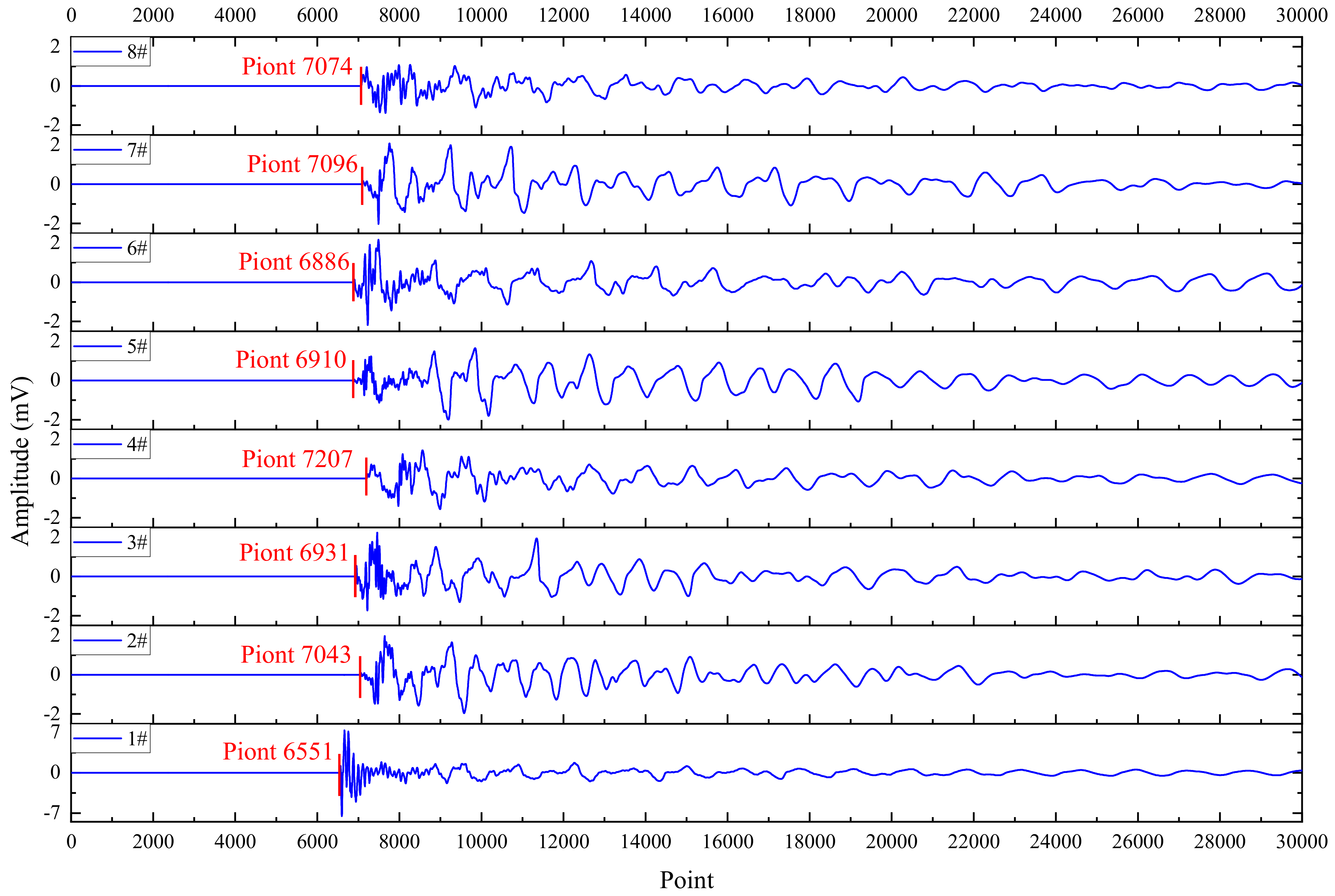

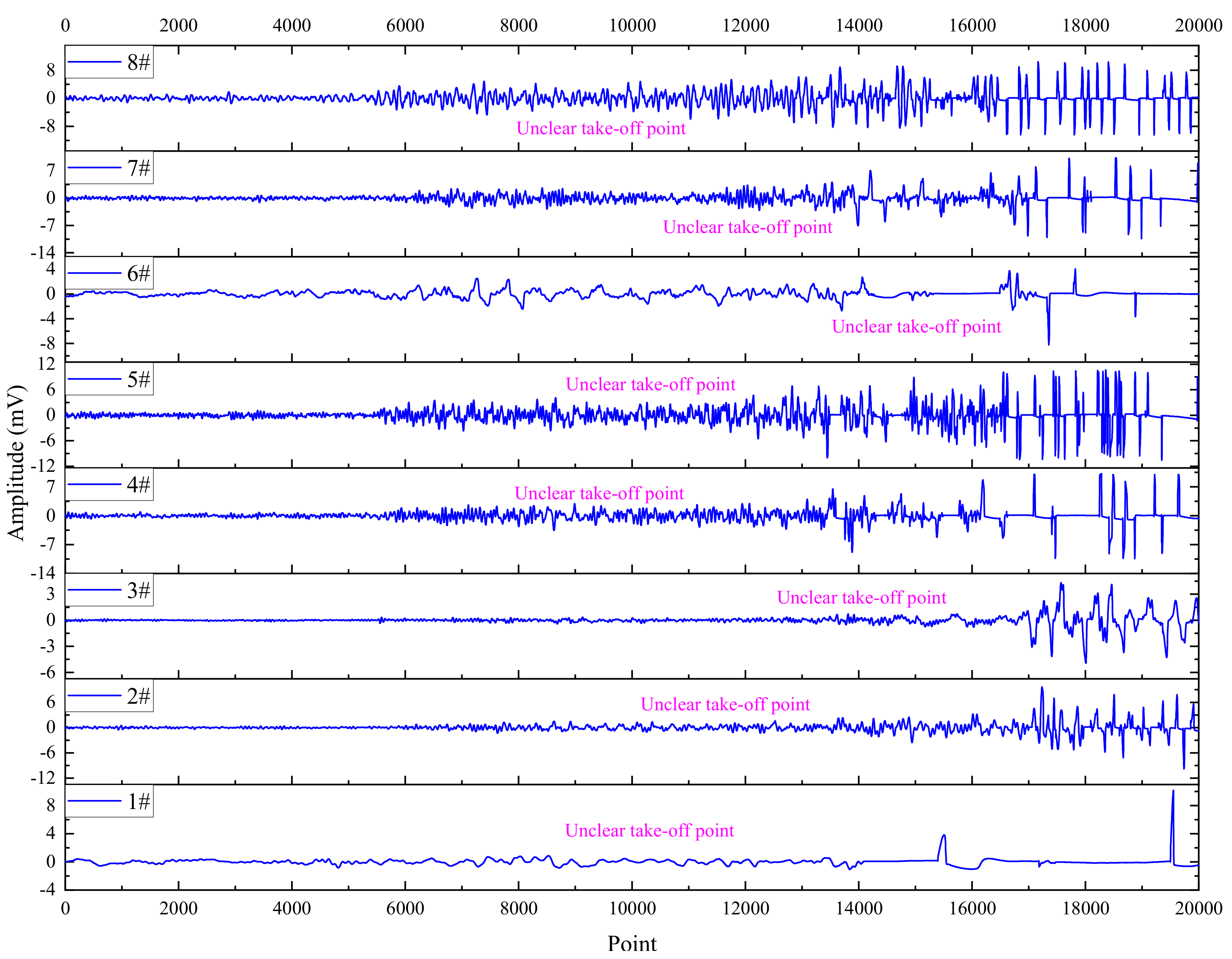

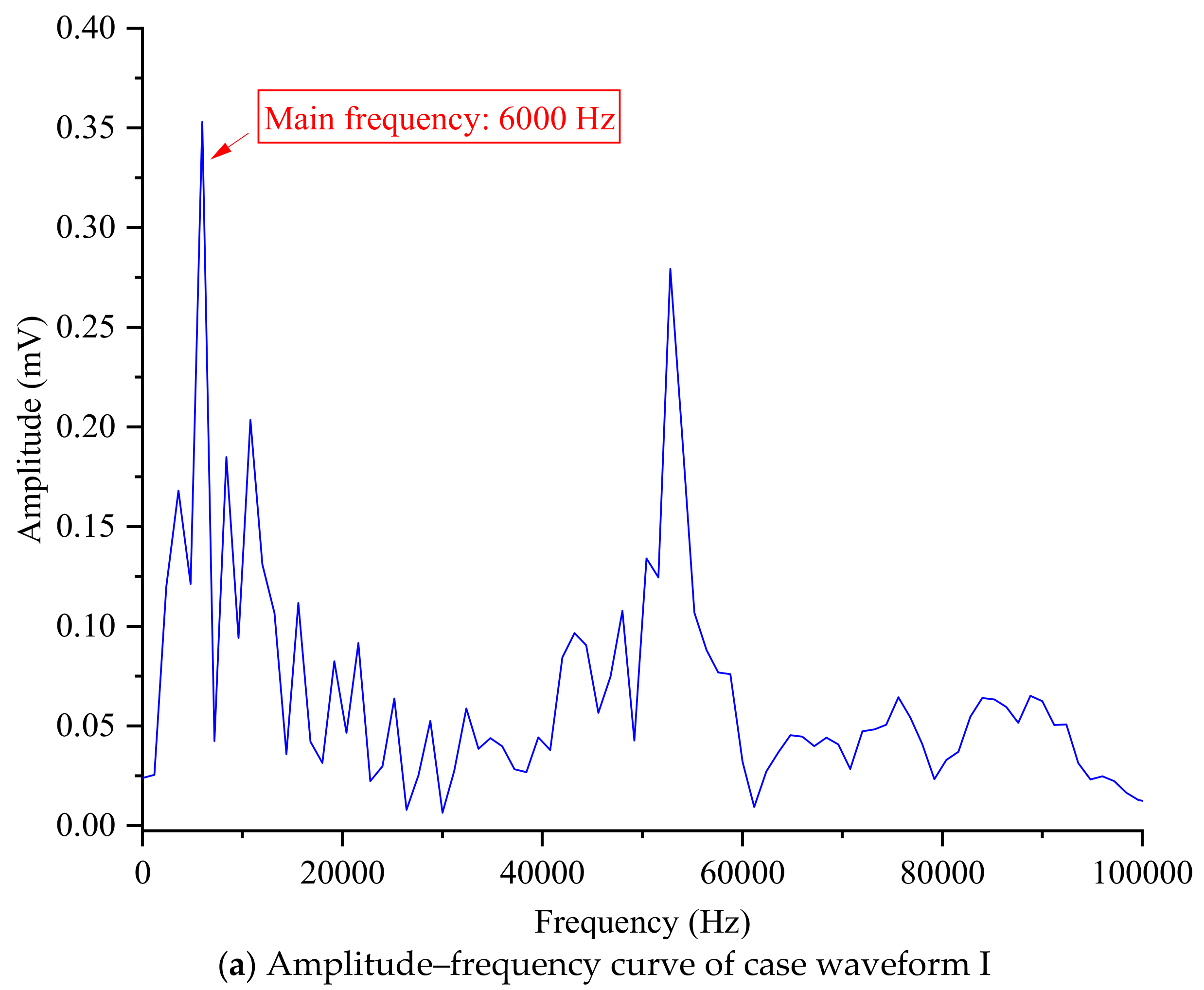

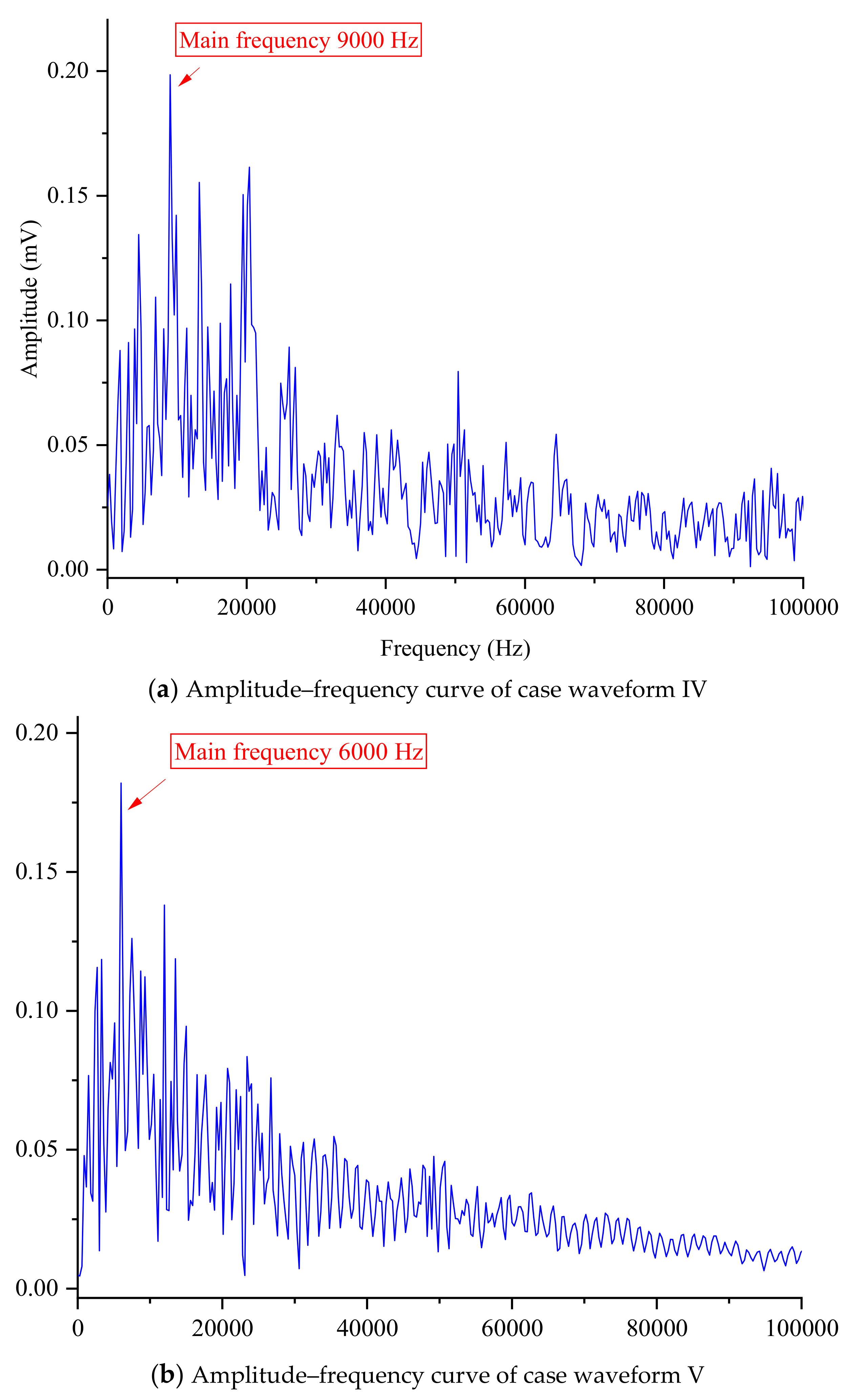
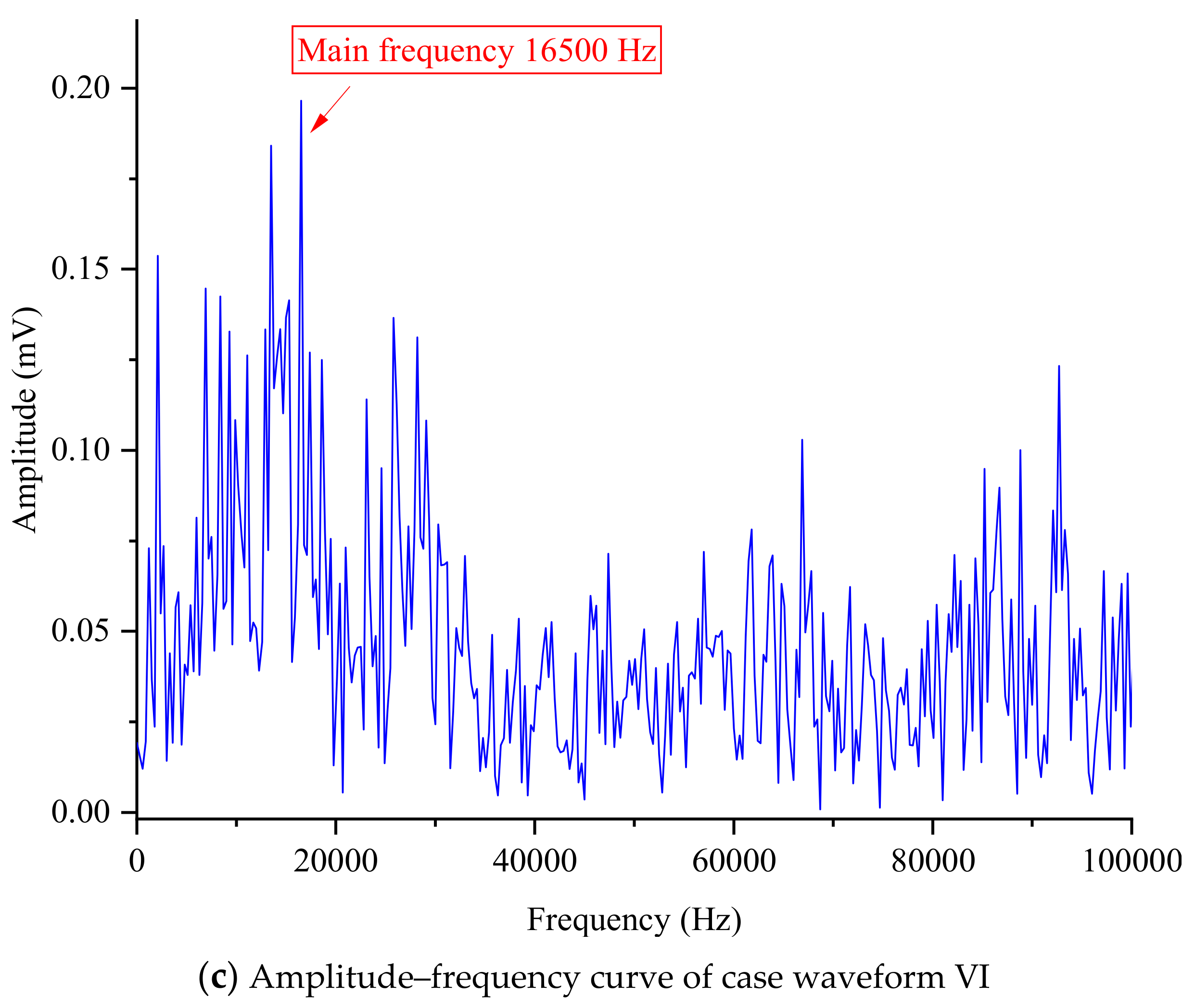
| Sensors | Coordinate | Sensors | Coordinate |
|---|---|---|---|
| Sensor 1# | (180, 0, 20) | Sensor 5# | (180, 180, 20) |
| Sensor 2# | (20, 0, 180) | Sensor 6# | (180, 20, 180) |
| Sensor 3# | (0, 20, 20) | Sensor 7# | (20, 180, 20) |
| Sensor 4# | (0, 180, 180) | Sensor 8# | (180, 180, 180) |
Disclaimer/Publisher’s Note: The statements, opinions and data contained in all publications are solely those of the individual author(s) and contributor(s) and not of MDPI and/or the editor(s). MDPI and/or the editor(s) disclaim responsibility for any injury to people or property resulting from any ideas, methods, instructions or products referred to in the content. |
© 2024 by the authors. Licensee MDPI, Basel, Switzerland. This article is an open access article distributed under the terms and conditions of the Creative Commons Attribution (CC BY) license (https://creativecommons.org/licenses/by/4.0/).
Share and Cite
Zhang, W.; Yu, J.; Xu, X.; Ren, J.; Liu, K.; Shi, H. Waveform Complexity and Positioning Analysis of Acoustic Emission Events during the Compression Failure Process of a Rock Burst Prone Sample. Buildings 2024, 14, 1331. https://doi.org/10.3390/buildings14051331
Zhang W, Yu J, Xu X, Ren J, Liu K, Shi H. Waveform Complexity and Positioning Analysis of Acoustic Emission Events during the Compression Failure Process of a Rock Burst Prone Sample. Buildings. 2024; 14(5):1331. https://doi.org/10.3390/buildings14051331
Chicago/Turabian StyleZhang, Wenlong, Jiajia Yu, Xiufeng Xu, Jianju Ren, Kaide Liu, and Huifang Shi. 2024. "Waveform Complexity and Positioning Analysis of Acoustic Emission Events during the Compression Failure Process of a Rock Burst Prone Sample" Buildings 14, no. 5: 1331. https://doi.org/10.3390/buildings14051331







